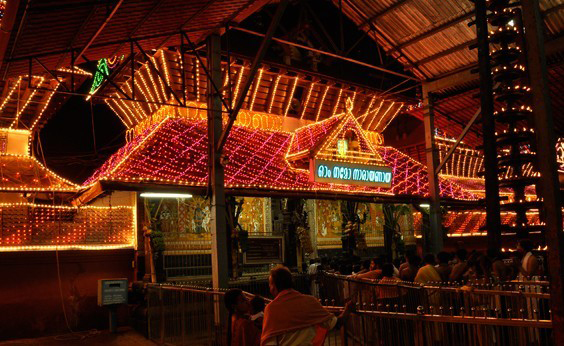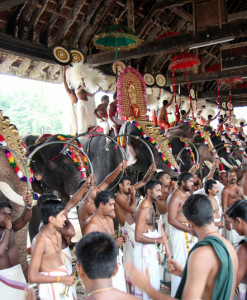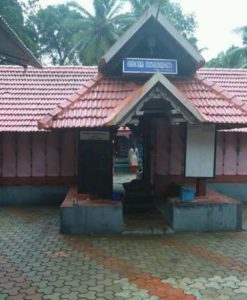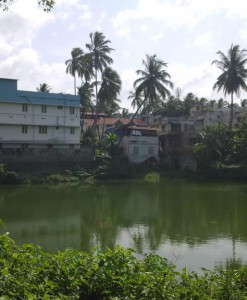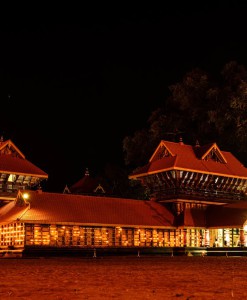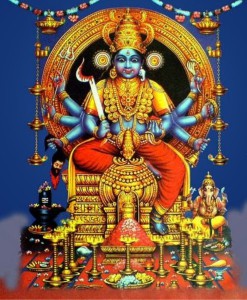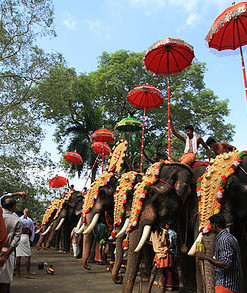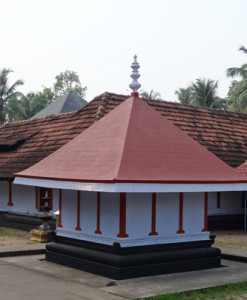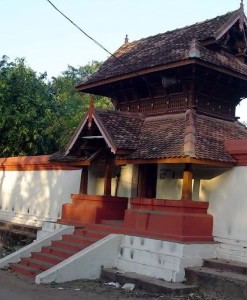No products in the cart.
Sree Guruvayurappan Temple, Guruvayur
Sree Guruvayurappan temple, also known as Guruvayur Sri Krishna temple is a famous temple, positioned in the Guruvayur town, Thrissur district in the state of Kerala, India. The temple is dedicated to Lord Krishna. The temple is governed by the Guruvayur Devaswom Board. There is strict dress code to be followed inside the temple.
The word Guruvayurappan, meaning “Lord of Guruvayoor”, comes from the words “Guru” referring to “Brihaspati”, the Guru of the Devas, ”Vayus”, the God of Wind, and ”Appan”, meaning ‘father’ or ‘Lord’ in Malayam. Since Guru and Vayu installed Krishna’s deity, the name Guruvayoorappan was given to the deity.
The temple is built in the classical Kerala style of Architecture. Guruvayoor temple is a typical example for Kerala’s temple Vastuvidya . It faces the East with two Gopurams, one in the East and other in the West. The entire area between these Gopurams is covered with tiles and known as Anapanthal. At the centre of this is a square shaped pillared hall called Nalambalam, the outer wall of which is fixed with a gallery of oil lamps. At the south side of the Nalambalam, there is a sub shrine of Lord Ayyapan. In the north-east side of this shrine is the Koothambalam, where the dance performances were held during ancient times. In the front and the east side of Nalambalam, the Belikkal and Deepastambas – Pillar of lights are located. There are a number of such light pillars in the temple.
On the eastern side, there is a Deepastambam, 24 feet in height with thirteen circular receptacles to hold the wicks. Of the other two at West Gopuram, one is in the shape of a tree. Dwijasthamba is a flag-staff, around 70 feet height, fully covered with gold. The square shaped Sree Kovil has two stairs and three rooms inside. The inner most room is known as Garbhagriha. Here, the two doors and the roof are covered by Gold. The outer room is called Mukhamandapam. The wall of Sree Kovil is decorated with ancient murals. In the north-eastern side of the Sree Kovil is the temple well called Manikinar. In the North side of the temple, a sub shrine of Devi, ‘Edathirithi Kavu’ is situated. The Oottupura, the place for prasadauttu is also located in the north side Here, the daily lunch is arranged for the devotees .Next to it is the temple tank Rudratheertha which is located near the north side of the temple.
The Sanctum is designed in two layers with copper sheet roofing plated with gold. The deity is in the traditionally orthodox form of Mahavishnu, with all the compliments – four arms each carrying sankh (conch), chakra(wheel), gadha (club) and padmam (lotus). The Moolavigraha is made of Pathalanjana Shila and is considered extremely sacred. There are two more idols, one made of silver and the other of gold. These are used for the Seeveli and other processions. Generally the golden idol is used and the silver idol which is more older is taken out only for Arattu and on a few special occasions. There is a repletion of traditional mural paintings on all the three sides, depicting sequences from puranic tales and Krishnaleela. There are 101 bells, all made of silver and plated with gold. Sopanam, the steps leading to the Sreekovil, are made of stone with carvings and designs.
The history of the temple is written in the legend Narada Purana. It says that the King Parikshit, a descendant of the Kuru dynasty, being the grandson of the famous archer Arjuna, one among the Pandavas and the son of Abhimanyu, died due to the bite of Takshaka, a fierce snake, after being cursed by a Sage. His son Janmajeya tried to take revenge for this by conducting a fierce yaga named Sarpasatra. Many innocent snakes were killed in the ritual fire. But Takshaka did not die, because the snake had the power of Amrita, a liquid to prevent death. Thus, Janamejaya got cursed by snakes and he was affected with severe leprosy. His condition did not improve. Both his body and mind got weaker over time. Then, Sage Dattatreya appeared before him and requested him to worship Lord Mahavishnu of Guruvayoor to get rid of the curse.
The greatness of the temple, as said by the divine sage Dattatreya, is that during Padma Kalpa when Lord Brahma was performing his task of creation, Lord Vishnu appeared before him. When Lord Brahma requested his wish to get salvation to himself and his creations, Lord Vishnu gave an idol to him. Later, during Varaha Kalpa, Lord Brahma gave this idol to a King named Sutapass and his wife Prasni, who revered Lord Vishnu. They continued to worship, and finally Lord Vishnu appeared before them. He stated that he would himself be born as their son in four births, and in all those births, they would be blessed with the idol which they revered. Thus, in the first birth in Satya Yuga, the Lord was born as Prasnigarbha, the son of Sutapass and Prasni. Later, in Treta Yuga, when Sutapass and Prasni were born as Kashyapa and Aditi respectively, Lord Vishnu was born as Vamana, their son. Again later, in the same yuga, when they were born as Dasaratha and Kausalya respectively, the Lord was born as Rama, their son, and finally, in Dwapara Yuga, when they were born as Vasudeva and Devaki, the Lord was born as Krishna, their son. In all these births, the idol was also with them. Later, Lord Krishna, took the idol of himself to Dwarka, and began to worship it.
At last, when the Lord was ascending to heaven after his avatar, he told to his friend and devotee Uddhava that Dwaraka would be submerged with sea within a week and everyone expect the idol he worshipped would be destroyed, so that the idol should be given to Brihaspathi, the guru of devas and Vayu, the windgod.Uddhava took the idol from the sea and gave it to Brihaspati and Vayu. Lord Guru and Lord Vayu consecrated the idol here, hence the deity is called as Guruvayurappan.
The temple is open for devotees from 3 AM to 12.30 PM and from 4.30 PM to 9.15 PM.
| Name of the pooja | From | To |
| Nirmalyam | 3.00 am | 3.30 am |
| Oilabhishekam, Vakacharthu, Sankhabhishekam | 3.20 am | 3.30 am |
| Malar Nivedyam, Alankaram | 3.30 am | 4.15 am |
| Usha Nivedyam. | 4.15 am | 4.30 am |
| Ethirettu pooja followed by Usha pooja | 4.30 am | 6.15 am |
| Seeveli,Palabhishekam,Navakabhishekam, Pantheeradi Nivedyam, and Pooja | 7.15 am | 9.00 am |
| Ucha pooja (the noon pooja) | 11.30 am | 12.30 pm |
* Temple will be closed between 1.30pm.
* Temple reopens at 4.30 pm
| Reopens at 4.30 pm | ||
| Name of the pooja | From | To |
| Seeveli | 4.30 pm | 5.00 pm |
| Deeparadhana | 6.00 pm | 6.45 pm |
| Athazha pooja Nivedyam | 7.30 pm | 7.45 pm |
| Athazha pooja | 7.45 pm | 8.15 pm |
| Athazha seeveli | 8.45 pm | 9.00 pm |
| Thrippuka, Olavayana | 9.00 pm | 9.15 pm |
| The Sreekovil will be closed. On the day of Special Illuminations called “Vilakku” the Thripuka is performed after that. The Sreekovil will be closed after Thripuka. Then the Krishnanattam, a colourful traditional dance-drama on Lord Krishna’s life is enacted inside the Temple on specified days. | 9.15 pm | |
Utsavam
The utsavam in Guruvayur is in the month of Kumbham (Feb-Mar) and the celebrations are spread over a period of 10 days. The festival starts with the hoisting of the temple flag on the dwajasthamba on Pooyam day and ends with the holy dip (Aarattu) on Anizham day. A special event during the utsavam is the elephant race. The Guruvayur Devaswom has about 45 elephants now, all donated by devotees. No description of the elephants in this temple is complete without mentioning Padmanabhan and Kesavan. Padmanabhan was a very tall elephant and had a majestic bearing. He would allow no other elephant to carry the Thidambu. There are many stories about his kindness, devotion and unswerving loyalty to the Lord. In appreciation of his services, a gold chain was presented to him. A strange spectacle was seen in the Guruvayur temple in the year 1931, the day Padmanabhan died: the sandal paste with which the Lord was adorned split into two pieces and fell down. The two tusks and teeth of Padmanabhan are kept in Guruvayur.
Kesavan was donated by Raja of Nilambur and came to Guruvayur in 1922. He learnt from Padmanabhan the way he should conduct himself as a servant of the Lord. He was about 11 ft tall and would raise his front leg only when the Thidambu is to be mounted. All other riders, including his mahout, had to mount from the rear, using his hind leg. He was honoured with the title Gajaraja. In 1976, on Navami, he fell ill during the Sriveli. On the Dasami night, he used the drinking water (kept for him) to bathe and to clean his body and stood looking longingly in the direction of the Deity whom he had served for a long time. The morning of Ekadasi dawned. On the day Lord Krishna gave Vishwarupa Darshan to Arjuna, Kesavan lay prostrate on the ground with his trunk stretched towards the Lord. The Lord had given moksha to the Gajaraja, just before the Srikovil opened. Guruvayur Devaswom has erected a life size statue of Kesavan in one of their rest houses and his death anniversary is observed on Ekadasi day.
Ekadasi
The Guruvayur Ekadasi falls in the month of Vrischikam (Nov-Dec), on the 11th day of the bright fortnight. Once when Lord Mahavishnu visited the abode of Yama, he heard heart rending cries of people tortured for their sins. The Lord wanted to save them from more suffering and uttered the word Ekadesi. The very mention of the word removed all their sins. Observance of Ekadasi is believed to have a purifying effect. It is believed that the sins of a lifetime are washed away if one happens to see the Ekadesi Vilakku (festival of lights). Legend says that on Guruvayur Ekadasi, Lord Indra comes with Kamadhenu and gives all material wealth and offers worship to receive Sri Krishna’s blessings. On that day all the theerthas such as Kasi, Badri, Sabarigiri and Palani in addition to rivers like Ganga and Yamuna assemble in this sacred place. It is also said that it was the day on which the deity was consecrated, and also the day on which Lord Krishna gave Geethopadesam to Arjuna, who was unwell to see his relatives on inimical side. As a part of Ekadasi, a musical fest named ‘Chembai Sangeetholsavam’ is held, honouring Chembai Vaidyanatha Bhagavathar, a great musician who was a devotee of the Lord. The fest lasts for 15 days, ending on Ekadasi night. Also, special illuminations called ‘Ekadasi Vilakku’ starts a month before. On each day, there will be special illuminations by many families and on the last day (Ekadasi), Devaswom itself performs Udayasthamana Pooja, the biggest offering of the Lord.
Ashtami Rohini (Sreekrishna Jayanthi/Janmashtami)
This is a special day in all Krishna temples in India. This occasion remembers the birth of Lord Krishna, falling in the month of Chingam (Aug-Sept), on the 8th day of the dark fortnight, mostly coinciding with Rohini day, thus called Ashtami Rohini. Guruvayoor Devaswom celebrates Ashtami Rohini with all its glory. There will be a Bhagavatha Sapthaham as a part of Ashtami Rohini celebrations, with the story of Krishnavatharam falling on this day. On this day, the devotees are given a birthday feast. There will be processions through the town by many organizations like Balagokulam and Guruvayoor Nair Samajam. Palpayasam and Appam are the main offerings to the Lord on this day.
Vishu
This is considered to be one among the two major festivals in Kerala, falling on the first day of the month of Medam (Apr-May). Guruvayoor Temple is constructed in a manner that on this day, the rays of the rising sun falls on the feet of the Lord. On this day, the temple opens half an hour earlier (2:30 AM) for Vishukkani darshan. Melsanthi arranges ‘Kani’ in the Namaskaramandapam in front of the sreekovil, as first seen by the Lord. Later, devotees go with closed eyes until they see Kani. For Kani, there will be rice, fruits and vegetables, betel leaves, arecanut, metal mirror, konna flower, holy texts and coins. For the first devotees who completes darshan, Melsanthi gives ‘Vishukkaineettam’.
In Vaishakham month
Vaishakham is the second month in Saka calendar, after Chaitram. It is the period between the New Moon dates in Medam (Apr-May) and Edavam (May-Jun) months in Malayalam calendar. This is considered an auspicious time for doing good things and worship. It is also believed that one will get salvation by doing good things on these days. It is also considered an auspicious time for reading Bhagavatham. During these days, Guruvayoor Devaswom conducts ‘Akhanda Bhagavatha Parayanam’. Akshaya Tritiya and Narasimha Jayanti come during this period.
Kucheladinam
This is celebrated on the first Wednesday in the month of Dhanu (Dec-Jan). It is believed that it was on this day that Kuchela/Sudama, a classmate of Lord Krishna, went to see the Lord with ‘Aval’ (Beaten rice), thus getting the name. On this day, the main offering is also Aval Nivedyam. There will be a queue of devotees who come with this.
Poonthanam Janmadinam
This is celebrated on the Aswathi day in the month of Kumbham (Feb-Mar). It is the birthday of the devotional poet Poonthanam who is best known for his work ‘Jnanappna’ (In this poem, Poonthanam says: ‘Kumbhamasathilakunnu nammude janmanakshathramaswathinalennum’ (My birthday is on the Aswathi day in the month of Kumbham), thus it is celebrated so). On this day, there will be special programmes in Guruvayoor & Poonthanam Illam, situated in Keezhattur near Perinthalmanna in Malappuram district. Jnanappana is read throughout the day.
Narayaneeyadinam
This is celebrated on the 28th day in the month of Vrischikam (Nov-Dec). It is believed to be the day on which Melpathur Narayana Bhattathiri, another devotional poet, completed his magnum opus ‘Narayaneeyam‘ and got cured of paralysis, thus getting the name. Narayaneeyam is read throughout the day. It is also believed that this day coincided with Guruvayoor Ekadasi in the year Melppathur wrote Narayaneeyam (1586–87). In 2013, there was such a coincidence once again. There will be Narayaneeya Sapthaham as a part of this.
Krishnageethidinam
This is celebrated on the last day in the month of Thulam (Oct-Nov). It is believed to be the day on which Samoothiri Manavedan Raja completed his magnum opus ‘Krishnageethi’, thus getting the name. Samoothiri was a contemporary of Melppathur & Poonthanam, and saw both of them during his lifetime. He got the source to write Krishnageethi after getting a peacock feather, believed to be that of Lord Krishna himself. He is also the founder of the art form Krishnanattam, which is based on Krishnageethi. Kottarakkara Thamburan, inspired of this, made a new art form called Ramanattam, and with some changes in Ramanattam, a new art form came. It is called Kathakali, the cultural icon of Kerala. Krishnanattam is played on all days except Tuesday and practice period (June-Sept).
Mandalakalam
This is the 41 days, consisting of the whole month of Vrischikam (Nov-Dec) and the first 11 days of Dhanu (Dec-Jan). There are special arrangements for ‘Malayidal’ and ‘Kettunira’ in front of the Lord Ayyappa shrine here. Guruvayoor Ekadasi, Narayaneeya Dinam & Kucheladinam are celebrated during this holy period.
Edatharikathukavu Vela
This is the festival of Goddess Durga, the sub-deity of the temple, held in the month of Dhanu (Dec-Jan). The Goddess here has more importance than other sub-deities, because she is believed to be the sister of Lord Krishna, who was here even before the main deity was intalled, and was shifted to the present place as a part of installing the new deity of Lord Vishnu. As a part of Vela, there will be ‘Kalamezhuthum Pattum’ held in front of the Goddess, from the first day of Dhanu until the Vela ends. There are two velas, one by the natives and the other by Devaswom itself. It is the only occasion in Guruvayoor on which fireworks are held. On this day, the nada closes an hour earlier, so that the Lord can also participate.
Navaratri
This is another major festival. All 9 days are considered very auspicious. On these days, the Goddess has special pujas. In the dusk of the 8th day (Durgashtami), the ‘Poojaveppu’ ceremony is held. The name came so that the books, musical instruments, weapons, etc. are placed for puja at the Koothambalam. On Vijayadashami day, many children come to have ‘Vidyarambham’. It is also the day of the first performance of Krishnanattam students.
The Poojas performed to the deity in this temple are Nirmalyam, Oilabhishekam, Vakacharthu, Sankhabhishekam, Malar Nivedyam, Alankaram, Usha Neivedyam, Ethirettu pooja, Seeveli, Palabhishekam, Navakabhishekam, Pantheeradi Nivedyam, Ucha Pooja, Seeveli, Deeparadhana, Athazha Pooja Neivedhyam, Athazha Pooja, Athazha Seeveli and Olavayana at 3 am, 3.20 am, 3.30 am, 4.15 am, 4.30 am, 7.15 am, 11.30 am, 4.30 pm, 6 pm, 7.30 pm, 7.45 pm, 8.45 pm, 9 pm and the closing of the temple at 9.30 pm respectively.
Info on the deity – Specific to the temple deity
The presiding, 5000 years old deity of the Guruvayur Temple is Lord Krishna, an incarnation of Lord Vishnu. The deity is four-armed, in a standing posture, carrying the conch, the discus (Sudharsana Chakra), the mace (Kaumodaki) and a lotus. This image represents the majestic form of Vishnu as revealed to Krishna’s parents during the time of Krishna’s birth. Hence Guruvayur is also known as the Dwaraka of South India. He is currently revered according to routines written by Adi Shankara.
Guruvayurappan Temple By Road
Guruvayur is 27 kms from Thrissur. The main bus stand is at a walkable distance of 650 m from the temple. Buses, auto-rickshaws and taxis are available almost all the time to reach the temple.
Guruvayurappan Temple By Rail
The nearest rail head is the Guruvayur Railway station at a distance of 1.5 kms from the temple.
Guruvayurappan Temple By Air
The nearest airport is the Cochin International Airport at a distance of 80 kms from the temple.
Sree Guruvayurappan Temple, Guruvayur,Kerala

